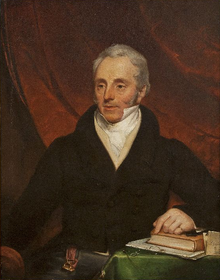The Second Arthur Guinness
| Arthur Guinness II | |
|---|---|

Portrait by Martin Creegan.
|
|
| Born | 12 March 1768 Beaumont, Dublin, Ireland |
| Died | 9 June 1855 Beaumont, Dublin, Ireland |
| Nationality | Irish (British) |
| Occupation | brewer, banker, politician |
| Known for | Guinness Brewery |
| Parent(s) | Arthur Guinness |
The Second Arthur Guinness (12 March 1768 – 9 June 1855) was a successful brewer, banker, politician and flour miller in Dublin, Ireland. To avoid confusion with his father Arthur Guinness (1725–1803), he is often known as the Second Arthur Guinness or as Arthur Guinness II or Arthur II Guinness.
Arthur was the second son of Arthur Guinness and his wife Olivia Whitmore, and was born at their home at Beaumont House (now a part of Beaumont Hospital, Dublin). He attended White's Academy in Grafton Street, Dublin, (now the site of Bewley's). Arthur started working for his father at the St James's Gate brewery from the 1780s. In 1790 his father, then aged 65, commented in a letter that the expansion of his brewery was partly due to his help:
On his marriage to Anne Lee in 1793 the lease of the brewery was assigned to their marriage settlement, proof that he was intended to take over the management of the brewery on his father's death. At the time his younger brothers Benjamin (d.1826) and William (d.1842) were also working in the brewery.
In 1782 his father had also founded the "Hibernian Mills" beside the River Camac in Kilmainham to mill flour for the expanding city's population. This was due to the expansion of Irish exports and commerce fostered from 1779 by the Irish Patriot Party, which the Guinnesses supported.
On his father's death in January 1803, he and his brothers Benjamin and William Lunell created a partnership trading as: "A. B. & W.L. Guinness & Co, brewers and flour millers". He bought Beaumont House from his elder brother the Revd. Hosea Guinness, who was Rector of St. Werburgh's Church, Dublin. In 1808 they bought their first steam engine from Boulton and Watt for pumping water.
Sales grew from 360,936 gallons in 1800 to 2,133,504 gallons by 1815. A slump followed, with sales dropping from 66,000 barrels to 27,000 by 1820.
...
Wikipedia
